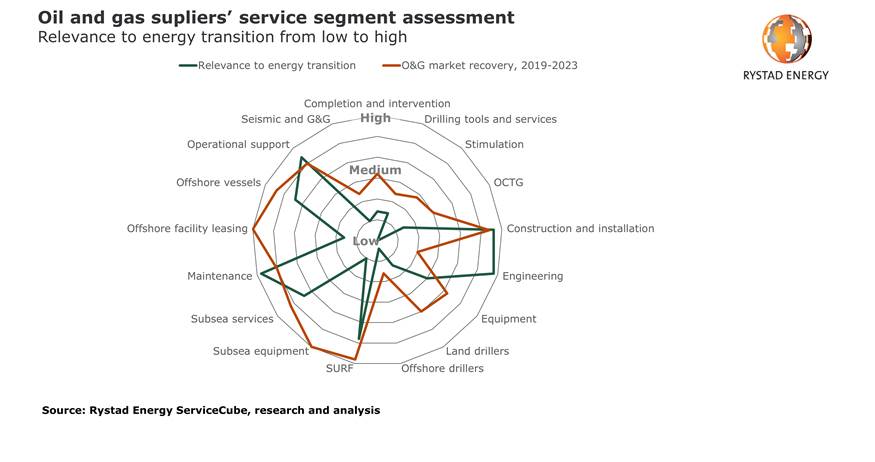Rystad: Energy transition projects could replace 40% of oilfield service revenues

Hit by the Covid-19 downturn, the oilfield service market is not likely to rebound to last year’s activity level until 2023 according to a Rystad Energy analysis.
However, suppliers could diversify some oil and gas capabilities and replace up to 40% of 2019’s revenue by servicing the renewable markets.
Rystad Energy analyzed the activity of the top 50 oil and gas suppliers, which together earned $220 billion in upstream revenue in 2019, $100 billion of which originated from well services and commodities.
Many services provided by well-focused suppliers will be challenging to deploy in the context of energy transition operations, especially fracking services, OCTG and drilling services and tools. However, the top contractors providing engineering, procurement, construction and installation (EPCI) services – which earned around $55 billion in 2019 from the oil and gas industry – will find it easier to apply their competencies towards the green shift.
“Around $90 billion, or 40% of the revenue from the top 50 players in the global service market, could potentially be replaced by energy transition projects, such as clean energy infrastructure and renewable energy production development services. However, the supply chain industry must also look to avenues outside of the energy transition to stay afloat,” says Rystad Energy’s Head of Energy Services Research Audun Martinsen.

Market opportunities abound
In terms of market opportunities, most traditional oilfield service suppliers are looking to expand into low carbon segments, meaning technologies or services aiming to reduce or prevent emissions from oil and gas extraction and production. This can be done by offering more efficient operations and digital solutions. This is a space where most suppliers, regardless of current exposure in the service market, have a role to play.
Another emerging market within the energy transition is clean energy infrastructure, where suppliers can provide services to support blue and green hydrogen infrastructure, carbon capture and storage, or energy storage in general. This is a market where engineering houses, fabricators and equipment manufacturers will find big opportunities for growth and for synergies.
A third option within the energy transition is to supply the end-to-end development and operations of renewable power generation itself, for example by developing solar power plants, wind parks offshore and onshore, and geothermal energy. The solar energy supply chain is highly fragmented and has become essentially out-of-box, yet the wind market offers great potential for offshore contractors.
However, the risk and investment required for expanding into other energy markets beyond oil and gas will not be feasible for all oilfield service providers.
In terms of growth opportunities, the clean energy market represents a fast-growing industry. The installed capacity of all utility-scale global renewable energy assets has doubled every fifth year since 2010, and will total 1000 gigawatts (GWAC) in 2020, comprised of 600 GWAC of onshore wind capacity, 284 GWAC of utility PV capacity and 34 GWAC of offshore capacity. By 2025, we expect this number grow by at least 50% to 1500 GWAC, potentially reaching 1800 GWAC of global capacity in our high case.
Due to economies of scale and cost deflation, operator’s investment towards asset development will grow slower than capacity, but still much faster than the O&G market. In Europe for instance, investments in offshore wind will exceed offshore O&G investment as soon as 2022. Geothermal energy is also getting broader attention in the market, especially in Europe. [...]
SURF = the market for subsea cables and pipelines, and the installation of these mechanisms. As a key segment for the development of deepwater oil and gas operations, particularly the high growth markets of Brazil and Guyana, Rystad Energy believes the SURF segment will be on track to surpass 2019 market levels in 2023. In addition, SURF services will be in demand for both floating and grounded offshore wind – the fastest growing renewable energy segment. [...]
 |
| Hybrid thermo-photovoltaic leading Company |

Commenti
Posta un commento